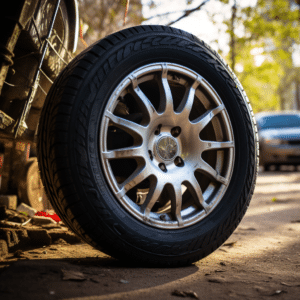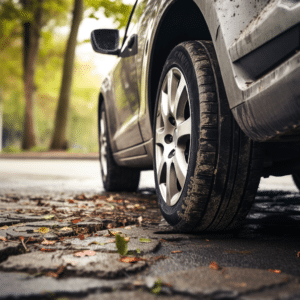
Putting Car Tires On Backwards: What You Should Know
Putting Car Tires On Backwards, If you really love your car, you need to take good care of it as an owner. Many automobile enthusiasts can attest that investing money and time in your vehicle gives the desirable aesthetic and driving qualities. You have the freedom to go for a sleek car with sophisticated style or something a little sporty, but in the long run vehicle customization is critical.
Tires are the key aspects of your car, and in most cases, you might forget to consider them for routine maintenance, servicing, and even customization. Although the appearance and tires sizes are the topics of frequent discussions, primarily for aesthetic reasons, the tread orientation is not brought to a major focus. However, if you’ve ever wondered if you can install the tires of your car backward, here is something you should know. Stay tuned; this article is meant for you.
When car tires are placed in the proper orientation, they perform optimally. That is because the tread pattern is engineered to work in a specific front-to-back direction to enhance the tire’s performance.
Installing your car tires backwards is possible. However, if it’s something that you would consider doing, you need to do extensive research to know the only tire variety that allows you to fix it backward.
Today, we’ll go over the three different types of tire treads, but only one of them can be put on backward. That means that there are only a few automobile tires that can be put on backward.
You’ve to choose a specific variety that can manage bi-directional movement. Although this may appear not the appropriate thing to do, there are certain advantages of putting your car tires backward.
What to Consider As You Put Your Car Tire On Backwards

Notably, if you want to put your car tire backward, you should first consider the tire pattern. Tire tread pattern refers to the lines seen when looking at the outside area of the rubber wheel. It’s the area that comes into contact with the road surface. Trend pattern design comes in different shapes and sizes. It tends to wear down slowly and become slicker over time as it is driven on.
The tread pattern is crucial because it creates friction for your car tires. That stops you from slipping on slick roads, especially at high speeds and wet roads on a rainy day. It also gives you good traction while on the sandy road surface.
Wet terrain during rain or snow might cause an accident if the tread on the tire is poor. As a result, tires are typically rotated every six months to wear evenly. Tire rotation maintains all four wheels running simultaneously as they wear down uniformly, preventing your automobile from leaning in one direction.
Importance of Putting the Car Tires on Backwards
As initially stated, some people believe that putting the tire backward does not require a response. Well, why do you have to put the car tire on backward? Is there any benefit from doing so? The quick answer is that mounting your automobile tires backward is helpful for maintenance and prolongation of the tire treads.
Because of the road conditions and the types of roads you travel on, your tires’ tread pattern might wear down unevenly over time when you drive your car for an extended period. That may happen even after rotating and changing your car tires as recommended, and it’s significantly more likely when the tire pops and only one is replaced. In that case, other tires are more likely to suffer from the imbalance that sets in.
If your automobile tires are capable of working effectively when put on backward, it’s something that you should always consider. Putting your car tires on backward can help them wear down more evenly and maintain the tread deeper and more efficiently for a more extended period.
Three Types of Tire Trends and Their Uses
There are three basic types of tire treads in the automobile industry that are often used. There are radial varieties divided into two subtypes, namely asymmetrical and symmetrical tires. Then there are the directional tires, also called unidirectional tires. Directional tires are the only ones that may be put on backward. All three tire treads serve distinct purposes and are employed for different reasons by car owners.
Now, let’s look at the distinctions between these tire treads;
Radial Tires
Radial tires are designed to only go in one direction and include an arrow on the sidewall to indicate how you need to put them. On the sidewall, there’s a single dot, usually bright red that lines up with the tubeless valve once it’s put correctly.
Radial tires come in two varieties, none of which may be installed backward. The tread pattern mounted on asymmetrical tire types varies across the face of the tire and should not be reversed since each tread wears down at a different pace.
The tread designed for the inner part of the tire wears down slowly and can impact how the car drives if they are reversed. In addition, when the asymmetrical tire types are put on backward, they can also put the driver and passengers at risk.
Tires with symmetrical tread design feature a single pattern that runs the entire length of the tire. They are more directional and should be put with the pointing arrow facing the vehicle’s front. If the direction of the symmetrical tire is slightly altered, the pattern is shifted.
Unidirectional Tires
A directional tread with a pattern that flows in one direction is found on a unidirectional tire. The lateral grooves on the sides can point in the same direction with the middle or cut straight across. The unidirectional tire design enhances the tire’s capacity to expel water while driving.
What to Expect If You Put Your Car Tires On Backwards

It is possible to drive with your tires on backward, although it is not recommended for long periods. Turning your automobile tire backward will equal out wear, but you’ll lose hydroplaning and high-speed performance.
Backing up unidirectional tires reverses the directional thread. That means the thread’s aim was not met because it couldn’t perform its duty. That may enhance accident risk.
The common assumption that putting a tire backward will damage the wheel’s mechanisms, not just the tire, is false.
